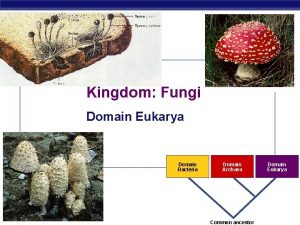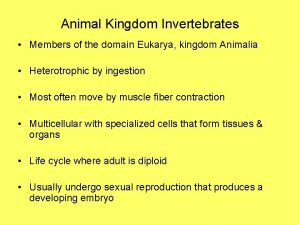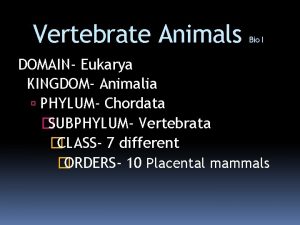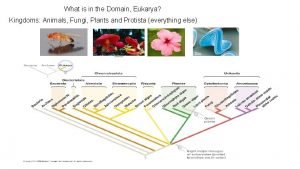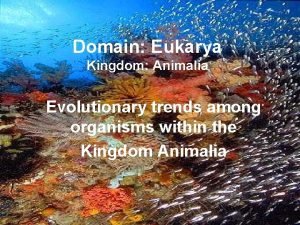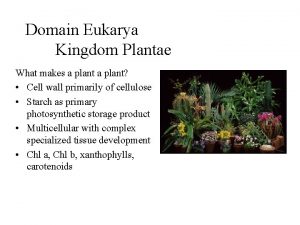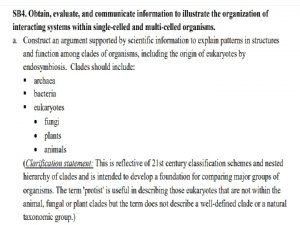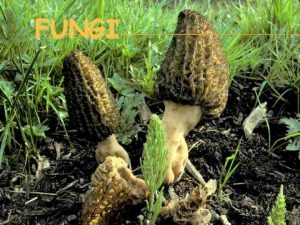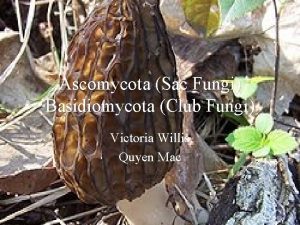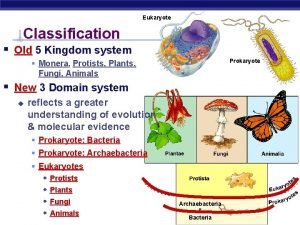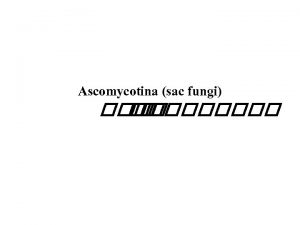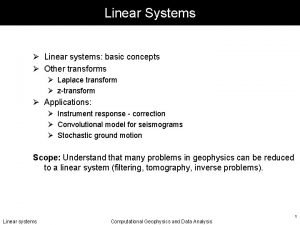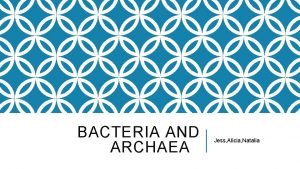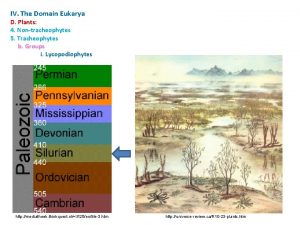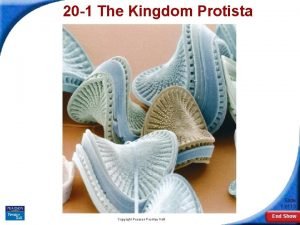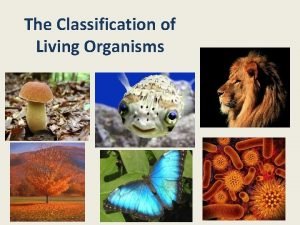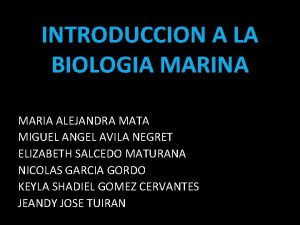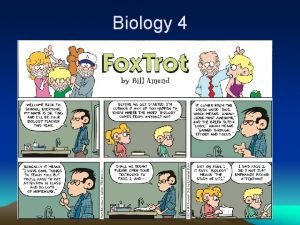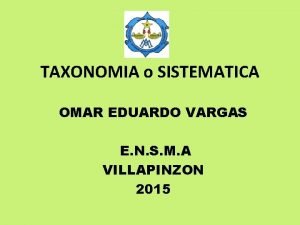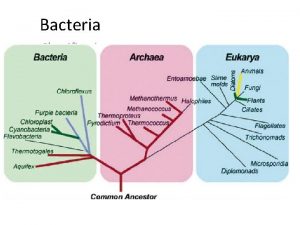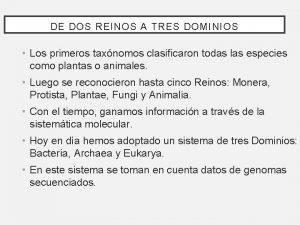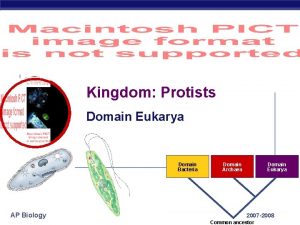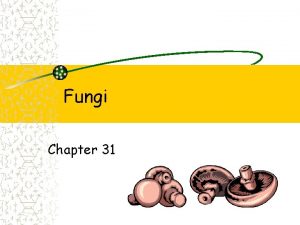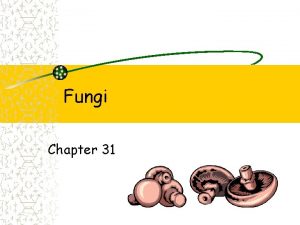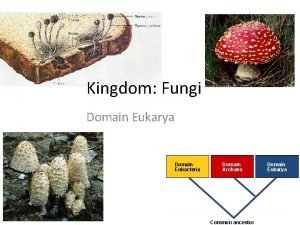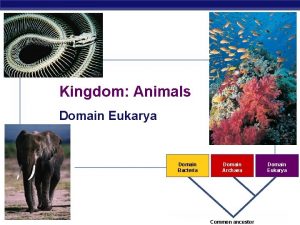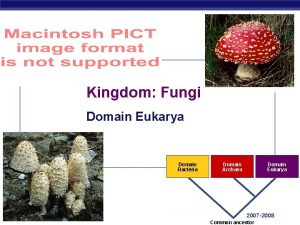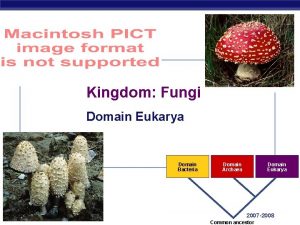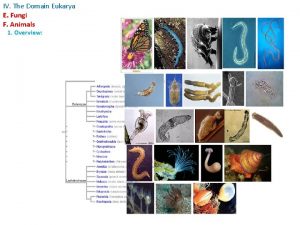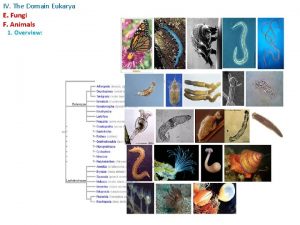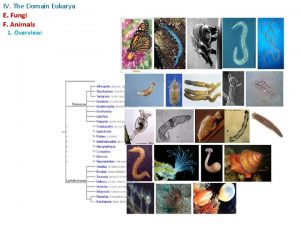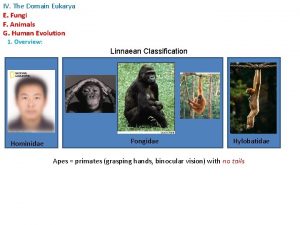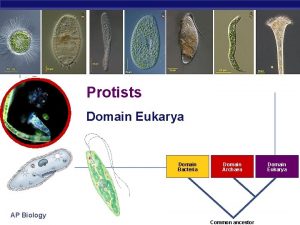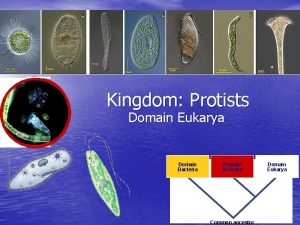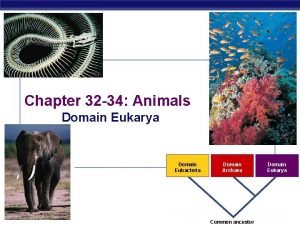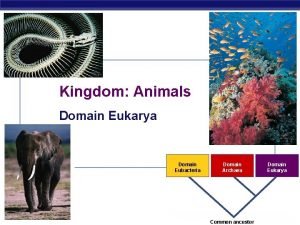IV The Domain Eukarya E Fungi F Animals































































- Slides: 63

IV. The Domain Eukarya E. Fungi F. Animals 1. Overview:

IV. The Domain Eukarya E. Fungi F. Animals 1. Overview: - Multicellular , heterotrophic eukaryotes that lack a cell wall - Choanoflagellate ancestry - Oldest animal fossils date to 650 mya - Major radiation of phyla 550 mya – Cambrian ‘Explosion’ evolution of predatory Cnidarians selected for evolution of hard parts that fossilize more readily.

IV. The Domain Eukarya E. Fungi F. Animals 1. Overview: 32 Animal Phyla: 95% of species are ‘invertebrates’ (85% are Arthropods); most are marine

IV. The Domain Eukarya E. Fungi F. Animals 1. Overview: 32 Animal Phyla

IV. The Domain Eukarya E. Fungi F. Animals 1. Overview: 32 Animal Phyla

IV. The Domain Eukarya E. Fungi F. Animals 1. Overview: 32 Animal Phyla

IV. The Domain Eukarya E. Fungi F. Animals 1. Overview: 2. Development:

IV. The Domain Eukarya E. Fungi F. Animals 1. Overview: 2. Development: 3. Body Plans: 4. Phylogeny: 5. Major “Invertebrate” Phyla a. Porifera: Sponges Intracellular digestion Cellular ‘circulatory’ system Asymmetrical Cells loosely integrated

5. Major “Invertebrate” Phyla a. Porifera: Sponges b. Cnidaria: Corals, Hydra, Anemones, Jellyfish

5. Major “Invertebrate” Phyla a. Porifera: Sponges b. Cnidaria: Corals, Hydra, Anemones, Jellyfish “Bilateria” – bilateral symmetry cephalization: getting a head

5. Major “Invertebrate” Phyla a. Porifera: Sponges b. Cnidaria: Corals, Hydra, Anemones, Jellyfish Protostomes - Lophotrochozoans

5. Major “Invertebrate” Phyla a. Porifera: Sponges b. Cnidaria: Corals, Hydra, Anemones, Jellyfish Protostomes - Lophotrochozoans

5. Major “Invertebrate” Phyla a. Porifera: Sponges b. Cnidaria: Corals, Hydra, Anemones, Jellyfish c. Platyhelminthes: Flatworms

5. Major “Invertebrate” Phyla a. Porifera: Sponges b. Cnidaria: Corals, Hydra, Anemones, Jellyfish c. Platyhelminthes: Flatworms Cephalization: eyespots and auricles Gastrovascular cavity convoluted gut Ameobocytes

5. Major “Invertebrate” Phyla a. Porifera: Sponges b. Cnidaria: Corals, Hydra, Anemones, Jellyfish c. Platyhelminthes: Flatworms Parasitic forms: Flukes Asexual reproduction – population increase!

5. Major “Invertebrate” Phyla a. Porifera: Sponges b. Cnidaria: Corals, Hydra, Anemones, Jellyfish c. Platyhelminthes: Flatworms Parasitic forms: Tapeworm

5. Major “Invertebrate” Phyla a. Porifera: Sponges b. Cnidaria: Corals, Hydra, Anemones, Jellyfish c. Platyhelminthes: Flatworms d. Annelida: Segmented worms Oligochaete (‘earth’) worms Polychaete worms Leeches

5. Major “Invertebrate” Phyla a. Porifera: Sponges b. Cnidaria: Corals, Hydra, Anemones, Jellyfish c. Platyhelminthes: Flatworms d. Annelida: Segmented worms Body cavity (coelom) Hydrostatic ‘skeleton’ Complete gut (‘tract’) Cephalization Segmentation

5. Major “Invertebrate” Phyla a. Porifera: Sponges b. Cnidaria: Corals, Hydra, Anemones, Jellyfish c. Platyhelminthes: Flatworms d. Annelida: Segmented worms e. Mollusca: Chitons, snails, bivalves, cephalopods

5. Major “Invertebrate” Phyla a. Porifera: Sponges b. Cnidaria: Corals, Hydra, Anemones, Jellyfish c. Platyhelminthes: Flatworms d. Annelida: Segmented worms e. Mollusca: Chitons, snails, bivalves, cephalopods The ancestral state is segmentation as in the chitons. In the rest of the group there is reduction of sementation.

5. Major “Invertebrate” Phyla a. Porifera: Sponges b. Cnidaria: Corals, Hydra, Anemones, Jellyfish c. Platyhelminthes: Flatworms d. Annelida: Segmented worms e. Mollusca: Chitons, snails, bivalves, cephalopods The ancestral state is segmentation, as in the chitons. In the rest of the group there is reduction of segmentation.

5. Major “Invertebrate” Phyla a. Porifera: Sponges b. Cnidaria: Corals, Hydra, Anemones, Jellyfish c. Platyhelminthes: Flatworms d. Annelida: Segmented worms e. Mollusca: Chitons, snails, bivalves, cephalopods In sessile bivalves, there has been ‘decephalization’ – loss of head

5. Major “Invertebrate” Phyla a. Porifera: Sponges b. Cnidaria: Corals, Hydra, Anemones, Jellyfish c. Platyhelminthes: Flatworms d. Annelida: Segmented worms e. Mollusca: Chitons, snails, bivalves, cephalopods In sessile bivalves, there has been ‘decephalization’ – loss of head Scallop eyes

5. Major “Invertebrate” Phyla a. Porifera: Sponges b. Cnidaria: Corals, Hydra, Anemones, Jellyfish c. Platyhelminthes: Flatworms d. Annelida: Segmented worms e. Mollusca: Chitons, snails, bivalves, cephalopods In cephalopods, the shell is reduced from external to internal bony to internal cartilaginous to gone

5. Major Phyla a. Porifera: Sponges b. Cnidaria: Corals, Hydra, Anemones, Jellyfish Protostomes: Lophotrochozoans c. Platyhelminthes: Flatworms d. Annelida: Segmented worms e. Mollusca: Chitons, snails, bivalves, cephalopods Protostomes: Ecdysozoans

5. Major Phyla Protostomes: Ecdysozoans f. Nematoda - molt four times, resecreting their cuticle each time - complete digestive tract - some cephalization with anterior neural ganglion - free living and parasitic -human parasites: trichinosis, filariasis, elephantiasis, Ascariasis (two foot intestinal worms)

5. Major Phyla Protostomes: Ecdysozoans f. Nematoda g. Tardigrada Cryptobiotic: can dehydrate to less than 1% of normal and endure for 10 years. Can endure the vaccuum of space and 6000 atmospheres of pressure. Thin exoskeleton, unjointed legs

5. Major Phyla Protostomes: Ecdysozoans f. Nematoda g. Tardigrada h. Onychophora Sister group to the Arthropods; thin exosleleton and unjointed legs, like tardigrades Predatory; immobilize prey by shooting glue

5. Major Phyla Protostomes: Ecdysozoans f. Nematoda g. Tardigrada h. Onychophora i. Arthropoda Exoskeleton Jointed legs Myriapoda Vericrustacea Mandibulata Crustacea Remipedes Hexapods Trilobita Arachnomorpha Xiphosura Chelicerata From Regier et al. (2010) Arachnids

5. Major Phyla Protostomes: Deuterostomes: j. Echinodermata Internal skeleton composed of interlocking plates of calcium carbonate. A system of internal canals fills and empties tube feet.

5. Major Phyla Protostomes: Deuterostomes: j. Echinodermata k. Hemichordata Hollow dorsal nerve cord Pharygeal gill slits All marine – some reach 8 ft in length

5. Major Phyla Protostomes: Deuterostomes: j. Echinodermata k. Hemichordata l. Chordata 4 characteristics: - hollow dorsal nerve chord - notochord - pharygeal gill slits - post-anal tail

5. Major Phyla Protostomes: Deuterostomes: j. Echinodermata k. Hemichordata l. Chordata subphyla: Urochordata “Tunicates”: Mobile larvae, sessile filter. Cephalochordata feeding adults - filter with the pharynx Vertebrata and gill slits.

5. Major Phyla Protostomes: Deuterostomes: j. Echinodermata k. Hemichordata l. Chordata subphyla: Urochordata Cephalochordata Vertebrata Mobile larvae, sessile filterfeeding adults - filter with the pharynx and gill slits.

5. Major Phyla Protostomes: Deuterostomes: j. Echinodermata k. Hemichordata l. Chordata subphyla: Urochordata Cephalochordata Vertebrata Pikaia – the earliest Chordate – dates from the Cambrian period

5. Major Phyla Protostomes: Deuterostomes: j. Echinodermata k. Hemichordata l. Chordata subphyla: Urochordata Cephalochordata Vertebrata “Jointed spine” – vertebrae. Although Hagfish lack this, so sometimes the group is called Craniata (has a skull)

Patterns in evolution: Innovation, radiation, competitive contraction

5. Major Phyla Deuterostomes: l. Chordata Vertebrata Hyperoartia: “Jawless fishes” Lampreys and Hagfish Lamprey larvae look very much like cephalochordates

5. Major Phyla Deuterostomes: I. Chordata Vertebrata Hyperoartia: “Jawless fishes” Evolve in late Cambrian, radiate in the Ordovician


5. Major Phyla Deuterostomes: l. Chordata Vertebrata Gnathostomes – Jawed Vertebrates Move from detritivores to predators

5. Major Phyla Deuterostomes: l. Chordata Vertebrata Gnathostomes – Jawed Vertebrates The Devonian was the “Age of Fishes” – a radiation of the first jawed vertebrates, dominated first by the Placoderms and then by Cartilaginous and bony fishes Arthrodires Placoderms Antiarchs Chondrichthyes (Sharks, rays) Acanthodians Teleosts Ray-finned Fishes Bony Fish Lobe-finned Fishes

5. Major Phyla Deuterostomes: l. Chordata Vertebrata Gnathostomes – Jawed Vertebrates The Devonian was the “Age of Fishes” – a radiation of the first jawed vertebrates, dominated first by the Placoderms and then by cartilaginous and bony fishes

5. Major Phyla Deuterostomes: l. Chordata Vertebrata Gnathostomes – Jawed Vertebrates Bony fishes dominate today: lighter skeleton and swim bladder Ray-finned Fishes Lobe-finned Fishes

5. Major Phyla Deuterostomes: l. Chordata Vertebrata Gnathostomes – Jawed Vertebrates Bony Fishes (Osteichthyes) comprise 40% of living vertebrate species

5. Major Phyla Deuterostomes: l. Chordata Vertebrata Gnathostomes - Tetrapods 350 mya Devonian 417 mya

Radiation of the “stem tetrapods” !!! Carboniferous Old friends a fish

5. Major Phyla Deuterostomes: l. Chordata Vertebrata Gnathostomes - Tetrapods Caecilians Salamanders Frogs


5. Major Phyla Deuterostomes: l. Chordata Vertebrata Gnathostomes Tetrapods - Amniotes The amniotic egg was a big advance Resist desiccation - amnion protects the embryo - yolk sac provides nourishment - allantoic sac holds waste produced by embryo Provision embryo allows for colonization of dry habitats

5. Major Phyla Deuterostomes: l. Chordata Vertebrata Gnathostomes Tetrapods - Amniotes SYNAPSID Amniote ancestor ANAPSID (turtles? ) Hylonomus Casineria DIAPSID

5. Major Phyla Deuterostomes: l. Chordata Vertebrata Gnathostomes Tetrapods - Amniotes The Permian Formation of Pangaea dries the landscape; amniotes dominate like the gymnosperms. shelled egg and the seed

5. Major Phyla Deuterostomes: l. Chordata Vertebrata Gnathostomes Tetrapods - Amniotes Dimetrodon – a Pelycosaur The Permian Pelycosaurs The synapsids radiate and dominate Dicynodonts Gorgonopsids Therapsids Cynodonts A cynodont Mammals

5. Major Phyla Deuterostomes: l. Chordata Vertebrata Gnathostomes Tetrapods - Amniotes Mammals - excellent transitional sequences from cynodont ‘reptiles’ - first fossils with all mammalian features (jaw, ear, dentition, fur) date to ~200 mya - Morganucodontids

Radiations of Mammals They diversify during the Mesozoic, but the modern groups radiate and dominate in the Cenozoic

5. Major Phyla Deuterostomes: l. Chordata Vertebrata Gnathostomes Tetrapods - Amniotes Mammals - Monotremes: egg laying, “sweat” milk - Placentals: Longer internal development allows for precocial behavior (independence on birth); placental allows for direct, energyefficient transfer of nutrients between blood systems of mother and offspring. Each energy transformation is less than 100% efficient Milk production in mammary glands FOOD for OFFSPRING DIGESTION Nutrients in bloodstream of mother Placenta - Marsupials: live birth to embryo – attaches to nipple to complete development. Mother does not need to abandon the nest/young to feed. FOOD Nutrients in bloodstream of offspring

5. Major Phyla Deuterostomes: l. Chordata Vertebrata Gnathostomes Tetrapods - Amniotes In the Mesozoic, the synapsids are replaced by the great diapsid radiations of Ichthyosaurs, Pterosaurs, and Dinosaurs Archosaurs: Dinosaurs, Pterosaurs, Crocodilians, Birds Lepidosaurs: Lizards, Snakes, Sphenodonts) Diapsida Ichthyosaurs Younginiformes

5. Major Phyla Deuterostomes: l. Chordata Vertebrata Gnathostomes Tetrapods - Amniotes - Archosaurs Crocodilians Pterosaurs Ornithiscians Dinosaurs Saurischians Sauropods Theropods Carnosaurs Birds


5. Major Phyla Deuterostomes: l. Chordata Vertebrata Gnathostomes Tetrapods - Amniotes Birds: (derived traits) No teeth Feathers and endothermy flight feathers keeled breastbone Clavicles united into wishbone Pneumatic skeleton (houses air sacs from respiratory system) Unidirectional respiration

Feathers: - ornamentation - endothermy (insulation) - lift (flight)

5. Major Phyla Deuterostomes: l. Chordata Vertebrata Gnathostomes Tetrapods - Amniotes In the Mesozoic, the synapsids are replaced by the great diapsid radiations of Ichthyosaurs, Pterosaurs, and Dinosaurs Archosaurs: Dinosaurs, Pterosaurs, Crocodilians, Birds Lepidosaurs: Lizards, Snakes, Sphenodonts) Diapsida Ichthyosaurs Younginiformes

5. Major Phyla Deuterostomes: l. Chordata Vertebrata Gnathostomes Tetrapods - Amniotes - Lepidosaurs Squamates Scales, moveable quadrate (double hinged jaw), hinged skull
 Domain of fungi
Domain of fungi Fungi eukarya
Fungi eukarya Domain eukarya kingdom fungi
Domain eukarya kingdom fungi Characteristics of eukarya
Characteristics of eukarya Domain vs kingdom
Domain vs kingdom Which are all members of the domain eukarya
Which are all members of the domain eukarya All vertebrate animals are in domain
All vertebrate animals are in domain Zoospory
Zoospory Domain eukarya kingdoms
Domain eukarya kingdoms Domain eukarya, kingdom animalia (or animal)
Domain eukarya, kingdom animalia (or animal) Coelom
Coelom Moss antheridia labeled
Moss antheridia labeled Is eubacteria in the domain eukarya
Is eubacteria in the domain eukarya Domain eukarya.
Domain eukarya. Domain eukarya chart
Domain eukarya chart 3 domain tree of life
3 domain tree of life Basidiomycota rusts and smuts
Basidiomycota rusts and smuts Fungi
Fungi Sac fungi
Sac fungi Bacteria kingdom monera
Bacteria kingdom monera G h patel college of engineering and technology
G h patel college of engineering and technology Animals that eat both plants and animals
Animals that eat both plants and animals Https://a-z-animals.com/animals/
Https://a-z-animals.com/animals/ Is a horse a producer consumer or decomposer
Is a horse a producer consumer or decomposer Sac fungi domain
Sac fungi domain Z transform tutorial
Z transform tutorial Problem domain vs knowledge domain
Problem domain vs knowledge domain Z domain to frequency domain
Z domain to frequency domain S domain to z domain
S domain to z domain What is time domain and frequency domain
What is time domain and frequency domain Domain specific vs domain general
Domain specific vs domain general Language processor mcq
Language processor mcq Z transform time reversal
Z transform time reversal Domain specific software engineering
Domain specific software engineering Introduction to functions (review game)
Introduction to functions (review game) Flowering plants phylum
Flowering plants phylum Archaea facts
Archaea facts Lycopodiophytes
Lycopodiophytes Protist evolution
Protist evolution Eukarya
Eukarya Domains biology
Domains biology Prokaryotic and eukaryotic cells worksheet
Prokaryotic and eukaryotic cells worksheet Dominio eukarya
Dominio eukarya Eukarya
Eukarya Clasificación de la papa
Clasificación de la papa Eukarya
Eukarya Bacteria vs archaea vs eukarya
Bacteria vs archaea vs eukarya Dominio eukarya reino protista
Dominio eukarya reino protista Los tres dominios son
Los tres dominios son Biology domain
Biology domain Từ ngữ thể hiện lòng nhân hậu
Từ ngữ thể hiện lòng nhân hậu Hổ sinh sản vào mùa nào
Hổ sinh sản vào mùa nào Diễn thế sinh thái là
Diễn thế sinh thái là Vẽ hình chiếu vuông góc của vật thể sau
Vẽ hình chiếu vuông góc của vật thể sau Phép trừ bù
Phép trừ bù Tỉ lệ cơ thể trẻ em
Tỉ lệ cơ thể trẻ em Lời thề hippocrates
Lời thề hippocrates đại từ thay thế
đại từ thay thế Vẽ hình chiếu đứng bằng cạnh của vật thể
Vẽ hình chiếu đứng bằng cạnh của vật thể Quá trình desamine hóa có thể tạo ra
Quá trình desamine hóa có thể tạo ra Môn thể thao bắt đầu bằng chữ f
Môn thể thao bắt đầu bằng chữ f Công thức tiính động năng
Công thức tiính động năng Thế nào là mạng điện lắp đặt kiểu nổi
Thế nào là mạng điện lắp đặt kiểu nổi Hát kết hợp bộ gõ cơ thể
Hát kết hợp bộ gõ cơ thể


